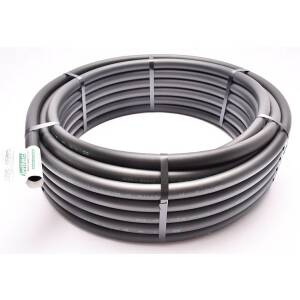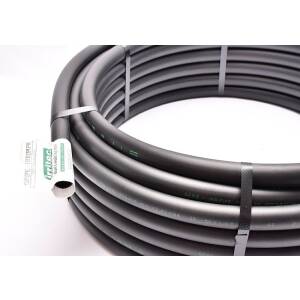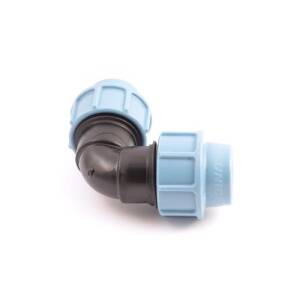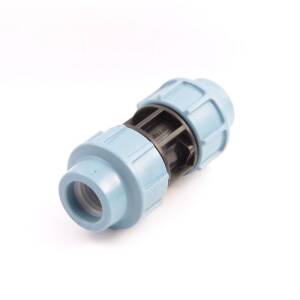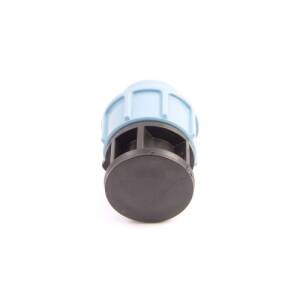Frequently Asked Questions (FAQs)
PE pipes are made of polyethylene, a flexible and robust plastic. They are resistant to UV radiation and corrosion, which makes them the ideal water pipe for your irrigation system. When installing irrigation systems, choosing suitable materials, such as PE pipes, is crucial for efficiency and stability. Thanks to their high quality and durability, they remain stable even when temperatures fluctuate. Their ease of use makes them the first choice for DIY garden projects.
Clamp connectors ensure a quick and tight connection between the PE pipes. They are easy to assemble, resistant to pressure changes and guarantee a long-term stable water pipe. With the appropriate seals, a leak-proof installation is created without the need for special tools.
The choice of PE pipe depends on the size of your garden and the required operating pressure.
- DA-25 PE pipe – ideal for a water volume of up to 1.8 m³/h or line lengths up to 100 m.
- DA-32 PE pipe – for larger gardens and higher water volumes.
- PE pipe irrigation with filter – protection against impurities. The right choice guarantees an efficient water supply and a long service life for your system.
Installation is easy:
- Cut the PE pipe to the desired size.
- Place the compression fitting on the pipe end.
- Fix the connection by tightening the seals.
- Add further connections or couplings.
- Check the operation for leaks.
Yes, PE pipes are frost-resistant, but it is advisable to empty the system before winter. Regular maintenance protects the water pipes and maintains the longevity of your garden irrigation.
The operating pressure is crucial for the choice of your PE pipe. Low-pressure systems (e.g. drip pipe) require pipes with low pressure resistance, while high-pressure systems must have a reinforced marking. The manufacturer indicates the maximum operating pressure, which you should take into account when planning.
In the DVS Beregnung range, you will find a wide selection of PE pipes, compression fittings and couplings in various sizes. These are easy to order and can be added directly to your shopping cart.
This is how you plan your PE pipe irrigation system optimally
Before you start installation, create a detailed sketch of your garden. Consider:
- The length of the lines and the required size of the PE pipes.
- The operating pressure of your water source.
- The number of couplings, female threads and male threads.
- The positioning of filters and pressure reducers.
Use the DVS irrigation planner to put together your individual system and find the right products.
Step-by-step guide to PE pipe installation
- Prepare materials: PE pipes, compression fittings, couplers, filters.
- Lay PE pipes: above or below ground in the planting zones.
- Connect the pipes with compression fittings and couplers.
- Insert filters to prevent contamination.
- Connect the system to the water source (with a system separator if necessary).
- Maintenance: Regularly check the operation and clean the seals.
DVS Beregnung offers all the items you need for your irrigation system. Choose high-quality PE pipes and clamp connectors from renowned manufacturers for sustainable and efficient garden irrigation!
Maintenance and repair of PE pipes
Maintaining and repairing PE pipes is crucial to ensuring the longevity and efficiency of your irrigation system. Here are some important aspects to keep in mind when maintaining and repairing PE pipes:
- Regular inspection: Perform regular inspections of your PE pipes to ensure that they are in good condition. Look for any signs of wear or damage that could affect the efficiency of your irrigation system.
- Filtering: Clean the water before it enters the irrigation pipes. Especially well water and rainwater. This protects PE pipes, nozzles and drippers from debris and impurities. This prevents blockages and ensures an even distribution of water in your garden.
- Repair: If damage to the PE pipes occurs, repairs should be made immediately. Use appropriate compression fittings and couplers to replace damaged sections and ensure a secure connection.
- Replacement: In the event of severe damage or when the PE pipes have reached the end of their service life, replacement should be considered. This ensures that your irrigation system continues to function efficiently and reliably.
With regular maintenance and timely repairs, you can extend the life of your PE pipes and ensure a continuous, efficient water supply in your garden.
 Free Online Irrigation-Planner
Free Online Irrigation-Planner












